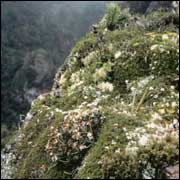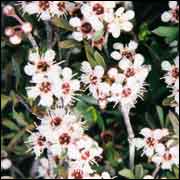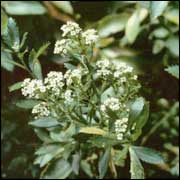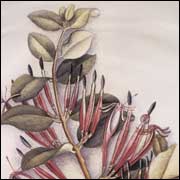|
Updated:
September 12, 2001
|
|
Endangered
Plants
Great
Barrier Island is at risk from a range of invading
plant pests.
Many are already on the island and people could easily
introduce others. Often this occurs accidentally. Seeds find
their way to the bottom of people's dirty boots or attached
to clothing or packs.
Marram
Grass
(Ammophila arenaria) This plant is a serious threat
to coastal dune and sandy areas. It competes with native
species such as pingao taking over large areas of dunes with
its extensive foliage and roots systems.
Apple
of Sodom
(Solanum linnaeanum) This introduced plant grows on
coastal sand dunes. It has a poisonous yellow fruit like an
apple and wavy leaves with prickles. The flowers are large
and purple. It grows into a shrub about 2m in height and is
found in the top half of the North Island including Great
Barrier Island.
GBI
has 50 plants that are threatened including the endemic
(found only on) Great
Barrier Island tree daisy.
The DoC programme of work includes learning more about the
habits and habitat of these plants and designing ways to
look after them.
Some
of the plants under threat are sand
tussock,
prostrate
kanuka,
coastal
cress
and northern
mistletoe.
Facts about each endangered plant are summarised in the
tables below.
Sand
Tussock
Austrofestuca littoralis

Once
found throughout the Auckland area, now only on
Great Barrier Island.
|
Habitat
- found
on sandy beaches, rear dunes
- close
to pohutukawa forest
- east
coast of Great Barrier Island
|
|
Threats
- pampas
- marram
- people
using dunes for recreational driving
- stock
grazing
|
Great
Barrier Tree Daisy
Olearia allomii

Endemic
to Great Barrier Island.
|
Habitat
- higher
sites
- often
logged area
|
|
Threats
- only
occurs on Great Barrier Island
|
Prostrate
Kanuka
Kunzea sinclairii

|
Habitat
- higher
altitudes
- rocky
outcrops
- acidic
soils
- low
shrubland
- often
with Great Barrier Island tree daisy
|
|
Threats
- hybridisation
with upright kanuka
|
Coastal
Cress
Lepdium oleraceum

Captain
Cook used this to prevent scurvy with his
crew.
|
Habitat
- off
shore islands of Great Barrier
- on
privately owned land
|
|
Threats
- habitat
destruction
- grazing
- exotic
plants invading habitat
- diseases
such as white rust
|
Northern
Mistletoe
Trilepidea adamsii

Once
found throughout the Auckland area, now only on
Great Barrier Island.
|
Habitat
- coastal
- open
shrubland, lowland forest
- grows
on hosts - mapou, mamangi and
wharangi
|
|
Threats
- over
collecting
- habitat
destruction
- (possum
browse on mainland sites)
|
Print
friendly page
|